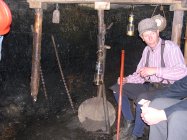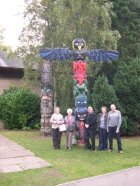
North East Holiday
| Thursday | Friday | Saturday | Sunday | Monday |

 |
Back to Heritage Group North East Holiday
|
 |
| Heritage
Group Trip to Middlesbrough & County Durham, October 2007 Thursday, on the way there; Bowes Museum at Barnard Castle.  The Bowes Museum was designed by John and Josephine Bowes in the 19th
century as a gift to the British people and it opened in
1892. It has a vast collection of famous paintings,
tapestries, wonderful ceramics, glass and furniture. The most
memorable to me is the life-size Silver Swan, an automaton made in 1773
and bought by John Bowes for £200. It is still in
working order and when set in motion it appears to preen itself and
then proceeds to take a fish out of the water and eat it.
The Bowes Museum was designed by John and Josephine Bowes in the 19th
century as a gift to the British people and it opened in
1892. It has a vast collection of famous paintings,
tapestries, wonderful ceramics, glass and furniture. The most
memorable to me is the life-size Silver Swan, an automaton made in 1773
and bought by John Bowes for £200. It is still in
working order and when set in motion it appears to preen itself and
then proceeds to take a fish out of the water and eat it.The museum is certainly well worth a visit. One could spend a whole day there. It is surrounded by parkland with a formal garden to the front. There is a cafe serving excellent meals or light refreshments. A lovely start to the holiday. June Gibbs Views of the town
Top of Page Beamish visit on Friday or “The Cobbled Road”. The steel tips of Billy’s clogs rang out on the wet cobbles and he pulled down his flat cap (very similar to the one Ken Bentley had purchased early in the day), to keep the driving rain off his face. He was making his way wearily up the hill back to the cottage after a long shift in the mine, hewing coal. In the kitchen his wife stirred the cooking pot hanging over the fireplace and the ten children stood at the table eagerly waiting for Ma to serve the meal. Up at the manor house, preparations were also under way for the dinner and Susie, the housemaid, was putting the finishing touches to the dining table laid out with the best china. So we enter Catherine Cookson country and a real mixture of poor and rich society. This was our experience on the visit to Beamish museum, spending the morning in 1825 and the afternoon in 1913. We had rides on restored trams and replica buses and attractions included an authentic town street, colliery village, a working farm, manor house and steam locomotives. Unlike Billy we were blessed with a lovely warm sunny day so life did not look so grim. We had the chance to visit all the buildings and learnt that the Barclays Bank on the main street had originally come from Stockport and been rebuilt at Beamish. The bank had all the old style fittings plus a selection of coins and bank notes from earlier times. In the basement there was a strong room full of boxes and trucks holding important papers and valuables, perhaps belonging to the wealthy people of the town.
Down at the mining village, mothers were baking and pulling rag rugs, as the washing hung on the maiden round the grate. No one was resting or drinking tea – life was hard and there were many jobs to do. In the village school visiting children were being taught in the junior classroom by a very strict teacher with a long stick and chanting out their nine times table.
 The drift mine gave visitors an opportunity to go into the dark, damp conditions experienced by miners and a number of our brave group took up the challenge. Today the mine still employs two Mine Deputies who have the traditional miner’s lamp and they have to check the mine for dangerous fumes every day before the visitors are allowed to enter. This museum is rooted in history and brought to life by its people to capture the spirit of North East England in the early 1800s and 1900s. We all really enjoyed our day with Billy and his colleagues and would recommend it as a fine day out. Catherine Cookson, alias Judith Ridgway Top of Page ---------------------------------------------------------------------------------------- The National Glass Centre, Sunderland Sunderland's Glass making heritage stretches back more than a thousand years and the National Glass Centre celebrates this as well as stocking a large range of work by the finest contemporary glassmakers from Britain and Europe.
Glass Blowing Demonstration - A Single Stem Vase
Top of Page Saturday - Visit to Durham City It looked like being another fine day as we set off after breakfast for our visit to Durham Cathedral and Durham Castle. As coaches are not allowed in the Old Town, half of our party went on the shuttle bus and the more energetic half walked up through the narrow cobbled streets to the Cathedral. The name Durham originates from Dunholm or "Island on a hill" and is situated on a crag surrounded on three sides by a meander of the River Wear. Durham was founded as a defensive and religious centre protecting northern England against the marauding Scots. The Cathedral and Castle site was one of the first designated a World Heritage Site and is one of the finest examples of Romanesque architecture on the planet.
The Cathedral Church of St. Mary & St. Cuthbert actually dates from 997 when the body of Cuthbert, Bishop of Lindisfarne, was brought to Durham. He died on 20th March 687 on the Farne Islands and was declared a Saint after many miracles were recorded at the site of his burial, one of which was that 11 years after his death, on opening his coffin, his body was found to show no signs of decay. Finally his body was laid to rest behind the High Altar in the new Norman Cathedral on 4th September 1104. The most notable aspects of the Cathedral were the Sanctuary Knocker, the magnificent internal ribbed vaulting, the Chapel of Nine Altars and of course the Shrine of St. Cuthbert. Click here for some official pictures. After lunch and a look round the market and market hall, which was first established in 1851, it was time for our visit to the Castle. Founded in 1072, the Castle was the Palace of the Prince Bishops whose powers were only second to the King. They had the power to raise their own armies, administer civil and criminal law, coin their own money etc. In fact, the Bishopric of Durham was a Kingdom within a Kingdom. In 1832, the then Bishop of Durham, William Van Mildert, founded University College in the medieval castle. The Castle is still part of Durham University with many highlights of Norman architecture including the Norman Chapel dating from 1080 and the great Norman Arch, which is a doorway into the Tunstall gallery and considered to be one of the finest examples of Romanesque carving in England. The historic grandeur of the Great Hall, built in 1284, is still used as the main dining hall and is one of the largest and most impressive of its kind in the country. There are now 14 Colleges at Durham University but none quite as impressive as "The Castle".
After all that medieval splendour it was time for the inevitable "cuppa" before boarding the coach. Several of us made our way to the modern Gala Theatre, a purpose-built £15M building in the Walkergate precinct and enjoyed our refreshment listening to a jazz trio. After a tiring but thoroughly enjoyable day we made our way back to the hotel with an even better knowledge of our Island, especially that special corner of the North-East. Grace Shaw Top of Page Sunday, The Captain Cook Birthplace Museum  The U3A Heritage Group set off on a misty Sunday morn The U3A Heritage Group set off on a misty Sunday morn to Marton where Captain Cook was born, ‘twas 27 October 1728. The museum has ‘hands on experience’ of the era - that was great! James Cook was a bright boy, although he lived on oatcakes made of bread and cruel he learnt basic reading and writing before going to ‘proper’ school. His ambition was to go to sea, at 16 he served as an apprentice on colliers at Whitby. James learnt the shipping business and technique of survey, practising his surveying skills in Gaspe Bay. He charted the St Lawrence river as far as Quebec, then adventures began aboard Endeavour, Adventurer and Discovery ships’ deck. This is a short tale of Captain Cook who loved the sea, who was killed by natives of Owyhee (Hawaii). Now High Lane U3A Heritage Group are in the know, what an interesting place to go! ----------------------------------------------------------------------------------------
Top of Page Monday - Exploring Ripon on the way home. Click here for Ripon Cathedral.
Top of Page |